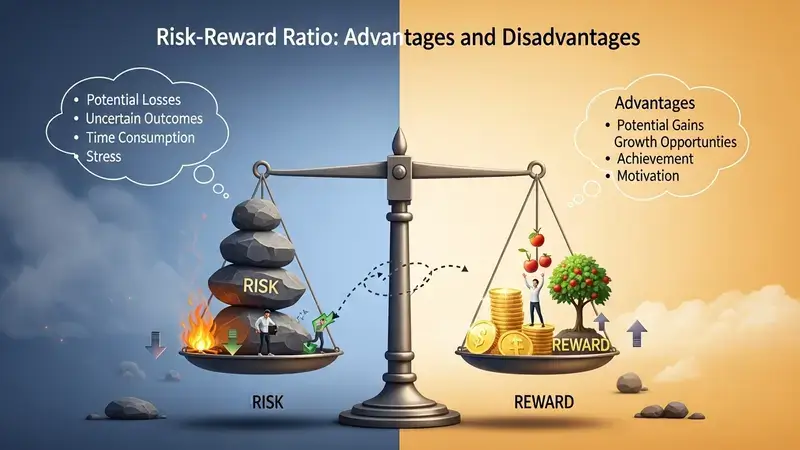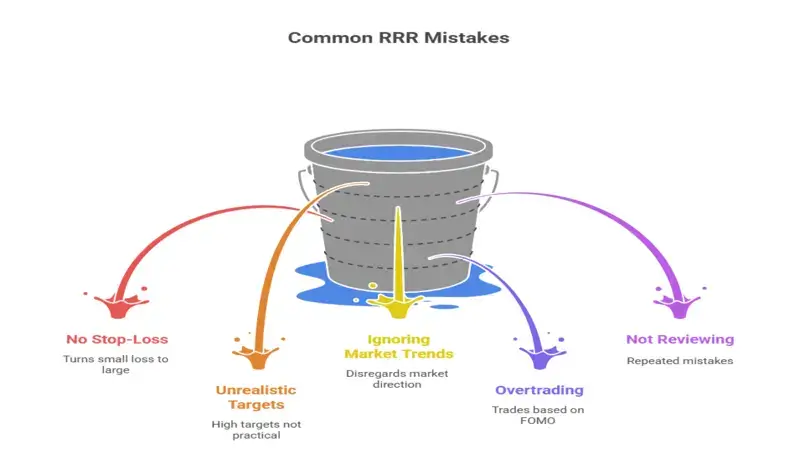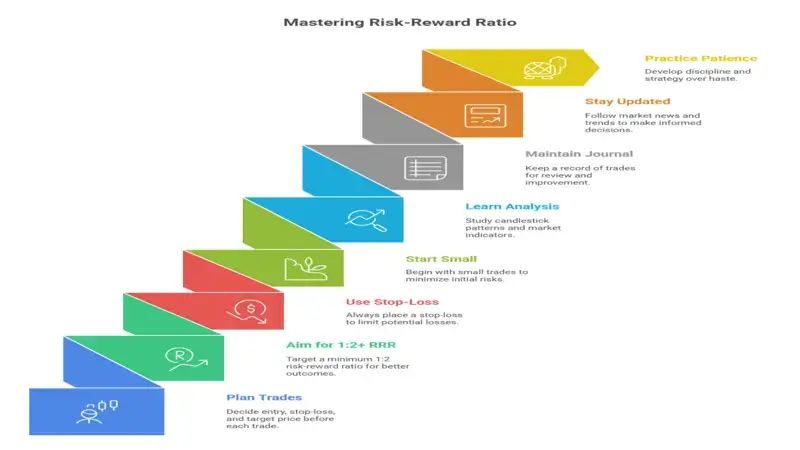क्या आपने कभी सोचा कि successful traders अपने पैसे को Share Market में कैसे सुरक्षित रखते हैं और consistent profits कमाते हैं?
इसका जवाब है Risk-Reward Ratio (RRR) ।
यह एक simple लेकिन powerful tool है, जो हर trader – चाहे beginner हो या expert को समझना चाहिए।
Risk-Reward Ratio आपको बताता है कि एक trade में आप कितना risk ले रहे हैं और बदले में कितना profit (reward) कमा सकते हैं। इसे समझकर आप emotional decisions, जैसे Revenge Trading से बच सकते हैं और अपने trading decisions को smart बना सकते हैं।
इस article में हम Risk-Reward Ratio को आसानी से समझेंगे। हम cover करेंगे कि RRR क्या है, यह कैसे काम करता है, इसे calculate कैसे करें, और यह आपके trading account को कैसे protect कर सकता है।
साथ ही, practical examples, actionable tips, और comparisons देंगे ताकि, आप इसे आज से ही apply कर सकें।
Page Contents
Risk-Reward Ratio क्या है?

Risk-Reward Ratio एक mathematical concept है, जो trading में यह measure करता है कि आप एक trade में कितना loss ले सकते हैं बनाम कितना profit कमा सकते हैं।
Simple words में, यह ratio बताता है कि एक रुपये के risk के बदले आपको कितने रुपये का reward मिल सकता है।
Formula:
Risk-Reward Ratio = Potential Risk / Potential Reward
Example:
मान लीजिए आप एक stock को ₹100 में खरीदते हैं। आपका stop-loss (जहां आप trade exit करेंगे अगर market आपके खिलाफ जाए) ₹95 है। यानी maximum risk = ₹5।
आपका target price (जहां आप profit book करेंगे) ₹110 है। यानी potential reward = ₹10।
Risk-Reward Ratio = ₹5 / ₹10 = 1:2 (1 रुपये risk के लिए 2 रुपये reward)।
इसका मतलब है कि अगर आप ₹5 का जोखिम लेते हैं, तो आपको ₹10 का profit मिल सकता है।
Ideally, traders 1:2, 1:3 या उससे बेहतर ratio prefer करते हैं ताकि long-term में profits losses से ज्यादा हों।
RRR को समझना ऐसा है, जैसे आप exam में marks और effort का हिसाब लगाते हैं।
जैसे अगर आप 2 घंटे पढ़कर 10 marks का सवाल solve कर सकते हैं, लेकिन 10 घंटे पढ़कर 20 marks का सवाल solve होता है, तो आप दूसरा option चुनेंगे।
Trading में भी RRR यही logic apply करता है – कम risk में ज्यादा reward.
Risk-Reward Ratio क्यों जरूरी है?
Risk-Reward Ratio trading का backbone है।
यह discipline और strategy का base बनाता है, जिससे आप market में survival और success दोनों achieve कर सकते हैं।
RRR महत्वपूर्ण क्यों है ?
- Losses को Control करता है: RRR से आप पहले से decide कर लेते हैं कि maximum कितना loss बर्दाश्त कर सकते हैं। इससे आपका capital सुरक्षित रहता है।
- Profits को Maximize करता है: RRR सुनिश्चित करता है कि आपके winning trades losing trades से ज्यादा profit दें।
- Emotional Trading रोकता है: जब आप RRR follow करते हैं, तो गुस्सा, Fear, या greed जैसे emotions decisions को control नहीं करते।
- Long-Term Success: Consistent RRR use करने से आपका trading performance stable रहता है
- Confidence बढ़ाता है: Clear risk-reward planning से आप बिना डर के trades ले सकते हैं।
Real-Life Example:
Priya, एक beginner trader, ₹50,000 के साथ trading शुरू करती है। बिना RRR के वह 5 trades में ₹20,000 का loss कर लेती है, क्योंकि वह randomly trades लेती है।
फिर वह 1:3 RRR strategy अपनाती है (₹1 risk के लिए ₹3 reward)।
अब 10 trades में 4 wins (₹12,000 profit) और 6 losses (₹6,000 loss) के बाद भी वह net ₹6,000 profit में रहती है।
SEBI की एक report के अनुसार, 71% intraday traders losses उठाते हैं क्योंकि, वे risk management ignore करते हैं। RRR इस gap को fill करता है और आपको disciplined trader बनाता है।
Risk-Reward Ratio कैसे Calculate करें?
RRR calculate करना बहुत आसान है। Follow these steps:
- Entry Price Decide करें: Stock या asset का price जहां आप trade शुरू करेंगे। Example: ₹200।
- Stop-Loss Set करें: Price जहां आप trade exit करेंगे अगर market आपके खिलाफ जाए। Example: ₹190।
- Target Price Set करें: Price जहां आप profit book करेंगे। Example: ₹230।
- Risk और Reward Calculate करें:
- Risk = Entry Price – Stop-Loss Price (₹200 – ₹190 = ₹10)
- Reward = Target Price – Entry Price (₹230 – ₹200 = ₹30)
- Ratio निकालें: Risk ÷ Reward = ₹10 / ₹30 = 1:3
Visual Example:
| Trade Component | Value |
| Entry Price | ₹200 |
| Stop-Loss | ₹190 |
| Target Price | ₹230 |
| Risk | ₹10 |
| Reward | ₹30 |
| Risk-Reward Ratio | 1:3 |
इस trade में, आप ₹10 risk लेकर ₹30 profit target कर रहे हैं। अगर आप 10 trades में 4 जीतते हैं और 6 हारते हैं, तो भी आप profit में रहेंगे:
- 4 wins = 4 × ₹30 = ₹120 profit
- 6 losses = 6 × ₹10 = ₹60 loss
- Net = ₹120 – ₹60 = ₹60 profit
Risk-Reward Ratio के Types और उनके Uses
RRR अलग-अलग ratios में इस्तेमाल होता है। यहाँ common ratios और उनके uses हैं:
- 1:1 Ratio:
- Risk और reward बराबर। Example: ₹5 risk, ₹5 reward।
- Use: Scalping या short-term trades में, जहां quick profits चाहिए।
- Drawback: Long-term में profits limited रहते हैं।
- 1:2 Ratio:
- 1 रुपये risk के लिए 2 रुपये reward।
- Use: Beginners और swing traders के लिए ideal।
- Example: Intraday trading में small moves capture करने के लिए।
- 1:3 Ratio or Higher:
- 1 रुपये risk के लिए 3 या ज्यादा रुपये reward।
- Use: Long-term investors और positional traders के लिए best।
- Example: Delivery trading में, जहां बड़े price movements की expectation हो।
Comparison Table:
| Ratio | Risk | Reward | Best For | Risk Level |
| 1:1 | ₹10 | ₹10 | Scalping | High |
| 1:2 | ₹10 | ₹20 | Intraday/Swing | Moderate |
| 1:3 | ₹10 | ₹30 | Positional | Low |
Risk-Reward Ratio के फायदे और नुकसान

| Aspect | Pros | Cons |
| Planning | Clear entry, exit, और target points देता है। | Market unpredictable होने पर targets miss हो सकते हैं। |
| Discipline | Emotional trading रोकता है। | Beginners को सही levels set करना मुश्किल लग सकता है। |
| Profitability | Long-term profits बढ़ाता है। | Short-term में losses possible हैं। |
| Flexibility | Any market (stocks, forex, crypto) में use हो सकता है। | Technical analysis की basic understanding चाहिए। |
Risk-Reward Ratio को Use करने के Practical Tips
RRR को effectively use करने के लिए ये actionable tips follow करें :
- Minimum 1:2 Ratio Choose करें: हमेशा trades लें जहां reward risk से कम से कम दोगुना हो। Example: ₹5 risk के लिए ₹10 या ज्यादा reward।
- Stop-Loss Strictly Follow करें: Emotions में आकर stop-loss change न करें। Example: अगर stop-loss ₹190 है, तो market गिरने पर उसे ₹185 न करें।
- Technical Analysis Use करें: Support और resistance levels, candlestick patterns, या moving averages से entry/exit points decide करें। Apps जैसे TradingView या Zerodha Kite help कर सकते हैं।
- Small Position Size रखें: Total capital का 1-2% से ज्यादा risk न लें। Example: ₹1,00,000 अकाउंट में, एक trade में ₹2,000 से ज्यादा risk न करें।
- Practice on Demo Account: Real money लगाने से पहले Zerodha, Upstox या Groww जैसे platforms पर demo trading करें।
- Trading Journal Maintain करें: हर trade का record रखें – entry price, stop-loss, target, और RRR। Example: “Entry: ₹150, Stop-Loss: ₹145, Target: ₹165, RRR: 1:3”।
- Stay Calm: Loss होने पर panic न करें। Break लें, market analyze करें, और RRR-based trade ही लें।
- Learn Continuously: YouTube channels जैसे Power of Stocks, Trade Brains या books जैसे Trading in the Zone से trading psychology और RRR सीखें।
- Market News Follow करें: Economic events, company results, या global news आपके RRR targets को affect कर सकते हैं। Apps जैसे Moneycontrol useful हैं।
Example Scenario:
- आप Nifty index पर intraday trading कर रहे हैं।
- Entry: 18,000, Stop-Loss: 17,900 (100 points risk), Target: 18,300 (300 points reward).
- RRR = 100 / 300 = 1:3.
- अगर आप 10 lots trade करते हैं (1 lot = ₹50), तो risk = ₹1,000 और reward = ₹3,000।
- Even if you win 4 out of 10 trades, you’re still profitable:
- 4 wins = 4 × ₹3,000 = ₹12,000
- 6 losses = 6 × ₹1,000 = ₹6,000
- Net = ₹6,000 profit
Common Mistakes in Using Risk-Reward Ratio

Beginners अक्सर RRR use करते समय ये mistakes करते हैं। इन्हें avoid करें:
- No Stop-Loss: Stop-loss न लगाना सबसे बड़ी गलती है। इससे small loss बड़ा loss बन जाता है
- Unrealistic Targets: बहुत बड़े reward targets set करना (जैसे 1:10) market conditions के हिसाब से practical नहीं होता।
- Ignoring Market Trends: RRR set करते समय market direction (bullish/bearish) ignore करना।
- Overtrading: RRR-based trades की जगह FOMO (Fear of Missing Out) में trades लेना।
- Not Reviewing: Trades का analysis न करना, जिससे mistakes repeat होती रहती हैं।
- Solution: Always stick to your RRR plan, use technical analysis, and review your trades weekly.
Common Myths About Risk-Reward Ratio
Risk-Reward Ratio को लेकर नए ट्रेडर्स में कई गलतफहमियां होती हैं।
| Myths | Truth |
| एक अच्छा RRR मुनाफे की गारंटी है। | RRR मुनाफे की गारंटी नहीं, बल्कि रिस्क मैनेजमेंट का एक टूल है। |
| जितना बड़ा RRR (जैसे 1:10), उतना बेहतर ट्रेड। | हमेशा नहीं। एक बहुत बड़ा RRR (जैसे 1:10) आकर्षक लग सकता है, लेकिन वह किसी काम का नहीं है। |
| RRR का मतलब है, कि मेरा Stop-Loss हिट नहीं होगा। | यह सबसे बड़ी गलतफहमी है। RRR का उद्देश्य नुकसान को रोकना नहीं, बल्कि उसे control करना है। |
| RRR सिर्फ Intraday या Short-term Trading के लिए है। | बिल्कुल नहीं, RRR हर तरह की Trading और Investment के लिए ज़रूरी है। |
Risk-Reward Ratio in Different Markets
RRR सिर्फ stock market तक limited नहीं है। इसे इन markets में भी use किया जा सकता है:
- Forex Trading: Currency pairs में small movements के लिए 1:2 RRR common है।
- Crypto Trading: Volatile markets में 1:3 या 1:4 RRR better होता है।
- Options Trading: High risk के कारण 1:5 RRR भी use होता है।
- Commodity Trading: Gold, silver जैसे assets में 1:2 या 1:3 RRR safe रहता है।
Example: Crypto में Bitcoin trading – Entry: $40,000, Stop-Loss: $39,000, Target: $43,000 → RRR = 1:3।
Advanced Tips for Using Risk-Reward Ratio
अगर आप RRR को next level पर ले जाना चाहते हैं, तो ये advanced tips try करें:
- Combine with Indicators: RSI, MACD, या Bollinger Bands जैसे indicators के साथ RRR use करें
- Adjust for Volatility: High volatility markets (जैसे crypto) में wider stop-loss और higher RRR set करें।
- Use Trailing Stop-Loss: Profits lock करने के लिए trailing stop-loss use करें।
- Example: Stock ₹200 से ₹220 जाता है, तो stop-loss को ₹210 करें।
- Backtest Your Strategy: Historical data पर अपनी RRR strategy test करें। Platforms जैसे MetaTrader या Amibroker help कर सकते हैं।
- Diversify Trades: One stock में सारा capital न लगाएं। Multiple sectors में RRR-based trades लें।
Actionable Steps to Master Risk-Reward Ratio:

- Plan Every Trade: हर trade से पहले entry, stop-loss, और target price decide करें।
- Aim for 1:2 or Better: Minimum 1:2 RRR target करें; 1:3 या 1:4 और बेहतर।
- Use Stop-Loss Religiously: Losses को limit करने के लिए stop-loss हमेशा लगाएं।
- Start Small: Beginners ₹1,000-₹2,000 per trade से शुरू करें।
- Learn Technical Analysis: Candlestick patterns, support-resistance, और indicators सीखें।YouTube channels जैसे Power of Stocks, Alpha Mind Trades, या Trade Brains से basics शुरू करें
- Maintain a Trading Journal: हर trade का record रखें और weekly review करें।
- Stay Updated: Market news और trends follow करें। Apps जैसे Moneycontrol या Economic Times use करें।
- Practice Patience: Trading में जल्दबाजी नहीं, discipline और strategy काम करती है।
Conclusion
Risk-Reward Ratio ट्रेडिंग में एक game-changer है। यह न सिर्फ आपके losses को control करता है, बल्कि आपके profits को maximize करके long-term success सुनिश्चित करता है।
बिना RRR के trading करना ऐसा है जैसे बिना नक्शे के समुद्र में जहाज चलाना – आप डूब सकते हैं।
लेकिन disciplined RRR strategy के साथ, आप market में confidence और clarity के साथ trades ले सकते हैं।
RRR को अपनाकर आप Revenge Trading जैसे traps से बच सकते हैं और अपने trading account को safe रख सकते हैं।
याद रखें: “Trading में risk है, लेकिन smart planning से profit भी है।”
आज से RRR apply करें, छोटे steps से शुरू करें, और अपने trading journey को profitable बनाएं। 🚀
Disclaimer: यह article educational purposes के लिए है। Stock market में Investment जोखिम भरा हो सकता है। कोई भी investment decision लेने से पहले अपने financial advisor से सलाह लें।
People also ask :
नए ट्रेडर्स के लिए 1:2 का Risk-Reward Ratio सबसे अच्छा माना जाता है। इसका मतलब है कि आप हर ₹1 के रिस्क पर ₹2 का मुनाफा कमाने का लक्ष्य रखते हैं, जो आपको कम Win Rate के साथ भी मुनाफे में रहने में मदद करता है।
आपको अपना Stop-Loss हमेशा एक लॉजिकल लेवल पर लगाना चाहिए, जैसे किसी सपोर्ट लेवल के ठीक नीचे (खरीदने पर) या रेजिस्टेंस लेवल के ठीक ऊपर (बेचने पर)। सिर्फ एक रैंडम प्रतिशत पर Stop-Loss लगाना एक आम गलती है।
हाँ, RRR और Position Sizing एक साथ काम करते हैं। RRR आपको बताता है कि कितना रिस्क लेना है, जबकि Position Sizing यह तय करता है कि आपको अपनी कुल पूंजी का कितने प्रतिशत एक ट्रेड में लगाना है ताकि आप बड़ा नुकसान न उठाएं।
बिल्कुल! जब आप एक तय RRR के साथ ट्रेड करते हैं, तो आप डर और लालच (Fear and Greed) जैसे इमोशंस से बचते हैं। यह आपको एक अनुशासित (disciplined) ट्रेडर बनाता है और Revenge Trading जैसी गलतियों को रोकता है।
हाँ, आमतौर पर Intraday Trading में छोटे मूव्स के लिए 1:2 या 1:1.5 का RRR इस्तेमाल होता है। वहीं, Swing Trading में बड़े टारगेट्स के लिए 1:3 या उससे ज़्यादा का RRR ज़्यादा फायदेमंद माना जाता है।

